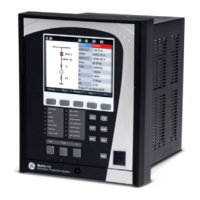4–382 889 GENERATOR PROTECTION SYSTEM – INSTRUCTION MANUAL
FLEXLOGIC CHAPTER 4: SETPOINTS
FLEXLOGIC RULES
When forming a FlexLogic™ equation, the sequence in the linear array of parameters must
follow these general rules:
1. Operands must precede the operator which uses the operands as inputs.
2. Operators have only one output. The output of an operator must be used to create a
Virtual Output if it is to be used as an input to two or more operators.
3. Assigning the output of an operator to a Virtual Output terminates the equation.
4. A timer operator (for example, "TIMER 1") or Virtual Output assignment (for example,
" = Virt Op 1") may only be used once. If this rule is broken, a syntax error will be
declared.
FLEXLOGIC EVALUATION
Each equation is evaluated in the order in which the parameters have been entered.
FlexLogic™ provides latches which by definition have a memory action, remaining in the
set state after the set input has been asserted. However, they are volatile; that is, they
reset on the re-application of control power.
When making changes to settings, all FlexLogic™ equations are re-compiled whenever
any new setting value is entered, so all latches are automatically reset. If it is necessary to
re-initialize FlexLogic™ during testing, for example, it is suggested to power the unit down
then back up.
Timers
Path: Setpoints > FlexLogic > Timers
There are 32 identical FlexLogic timers available. These timers can be used as operators for
FlexLogic equations.
TIMER 1 TYPE
Range: Milliseconds, Seconds, Minutes
Default: Milliseconds
The setpoint is used to select the time measuring unit.
TIMER 1 PICKUP DELAY
Range: 0 to 60000 s in steps of 1 s
Default: 0 s
The setpoint sets the time delay to Pickup. If a Pickup delay is not required, set this
function to "0”.
TIMER 1 DROPOUT DELAY
Range: 0 to 60000 s in steps of 1 s
Default: 0 s
The setpoint sets the time delay to Dropout. If a Dropout delay is not required, set this
function to "0”.

